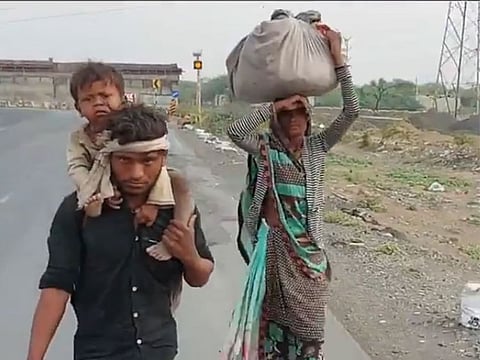Coronavirus lockdown: Battling hunger and poverty, these Indian migrant workers have walked nearly 700km over 15 days to return home
Coronavirus: Indian Tweeps question lawmakers what they are doing to #BringMigrantsHome

No jobs, no food or money. For millions of India’s migrant workers, the last few weeks have been all about two things - the fear of contracting COViD-19, or dying of hunger. In a Twitter video shared today by Indian journalist Barkha Dutt, another group of migrants were seen after having walked more than 500km over 15 days, from Kota in Rajasthan to Indore in Madhya Pradesh.
In the video, men, women and children are seen making their way back home. Some carry children on their shoulders as they walk long distances.
@BDUTT tweeted: “For when they say there are no Migrants on the Roads, in Week 5 of the lockdown, we have this report from National Highway 52, Jeera (cumin) cutters who have walked 500km carrying the universe on their shoulders.”
Questioning lawmakers in the country about the situation, some tweeps asked if anything was being done to address the situation. Many of them used the hashtag #BringMigrantsHome
Tweep @Bhim31118481: “You have the buses to bring back home students stuck in Kota, chartered planes to bring back people stuck outside India. Do you have any plan for the migrant workers who are stuck in different states or you have plans only for the richies? #BringMigrantsHome”
And, @prizone posted: “India's invisible migrant workers deserve to go home.”
Earlier in April, the central government had told the Supreme Court of India that more than 21,000 temporary shelters had been set up where close to 700,000 migrant workers had been accommodated across India and they were being given food and medical facilities.
In Dutt’s videos and other reports from India, however, many of these migrant workers say they have received no relief or help from the government. At shelters, they are not given food.
In an April 22 report, the World Bank highlighted that the nationwide lockdown in India which started about a month ago has impacted nearly 40 million internal migrants. Around 50,000-60,000 moved from urban centers to rural areas of origin in the span of a few days.
According to the report — ‘COVID-19 Crisis Through a Migration Lens’ — the magnitude of internal migration is about two-and-a-half times that of international migration.
Data from the Center for Monitoring Indian Economy (CMIE) has already revealed a large rise in unemployment — from 8.4 per cent on March 22 to 23.4 per cent on April 5.
Sign up for the Daily Briefing
Get the latest news and updates straight to your inbox








